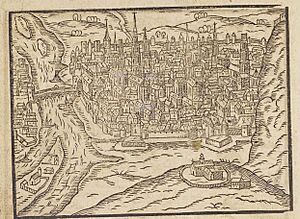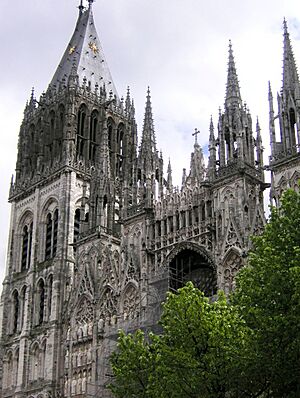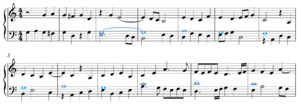Jean Titelouze facts for kids

Jean Titelouze (born around 1562 or 1563 – died October 24, 1633) was a French Catholic priest, a talented composer, a poet, and an organist. He lived during the late Renaissance and early Baroque periods. Titelouze worked as an organist and a priest (called a canon) at the famous Rouen Cathedral in France.
His music style was based on older Renaissance vocal music. It was quite different from the French organ music that became popular later in the 1600s. However, his collections of hymns and Magnificat settings for the organ were the very first published in France. Because of this, he is known as the first important composer of the French organ school.
Contents
Who was Jean Titelouze?

Jean Titelouze was born in a town called Saint-Omer in France, likely in 1562 or 1563. We don't know his exact birthday. He grew up and studied there. By 1585, he became a priest and worked as an organist at the Saint-Omer Cathedral.
Later that year, he moved to Rouen. In 1588, he became the main organist at the Rouen Cathedral, taking over from François Josseline. Titelouze didn't just play the organ in Rouen. He also traveled to other cities to help with organs. He gave advice on how to install new organs and how to fix important instruments.
Working with Crespin Carlier
In 1600, Titelouze invited a famous organ builder named Crespin Carlier to Rouen. Carlier was from the border region between France and Belgium. They worked together on the Rouen Cathedral organ. People at the time said it was the best organ in France! This instrument, and Carlier's other work, helped define what a "French classical organ" would be like. Titelouze sometimes helped Carlier with other organs too.
In 1604, Titelouze officially became a French citizen. This was important because Saint-Omer, where he was born, was part of the Spanish Netherlands at that time. In 1610, he became a "canon" at the Rouen Cathedral. This meant he was a special priest with duties related to the cathedral's daily life.
Awards and Publications
Titelouze was also a poet! In 1613, he won his first award from a literary group in Rouen called the Académie des Palinods. He won it for his poems.
In 1623, Titelouze published his first collection of organ music, called Hymnes de l'Eglise. This book contained organ pieces based on different plainchant hymns used in church services. That same year, because of health issues, he partly retired from his organist job. But he still kept the title until he died.
In 1626, he published his second organ collection, Le Magnificat. This book had eight different settings of the Magnificat, a special song from the Bible. In 1630, he won another award from the Académie des Palinods. He was even made "Prince des Palinods," a very high honor. He passed away three years later.
Friends and Influence
Titelouze was friends with Marin Mersenne. Mersenne was a very important French thinker who studied music, math, and philosophy. Seven letters they wrote to each other still exist, from 1622 to 1633. Titelouze even gave Mersenne advice for his big book, L'Harmonie Universelle.
Even though Titelouze's strict musical style soon became less common, his influence lasted for some time. For example, a composer named Nicolas Gigault wrote a piece in 1685 "in Titelouze's style." Much later, in the 1940s, another composer named Marcel Dupré wrote an organ piece called Le Tombeau de Titelouze (which means "Titelouze's Tomb") to honor him.
What Music Did Titelouze Write?
Titelouze's music that we still have today includes two collections of organ pieces. These were the first organ music collections ever published in France in the 1600s.
Hymns for the Organ
The first collection was called Hymnes de l'Église pour toucher sur l'orgue (Hymns of the Church to play on the organ). It was published in 1623, with a second edition in 1624. It has 12 different hymns:
- Ad coenam (4 parts)
- Veni Creator (4 parts)
- Pange lingua (3 parts)
- Ut queant laxis (3 parts)
- Ave maris stella (4 parts)
- Conditor alme siderum (3 parts)
- A solis ortus (3 parts)
- Exsultet coelum (3 parts)
- Annue Christe (3 parts)
- Sanctorum meritis (3 parts)
- Iste confessor (3 parts)
- Urbs Jerusalem (3 parts)
Each hymn usually starts with a part where the hymn melody is played slowly in one voice. Other voices play faster, more complex music around it. In some parts, the hymn melody moves between different voices. In a few pieces, two voices play a canon, which is like a musical round. Most of his pieces have four voices, except for the canon pieces, which have three.
Magnificat Settings
The second collection, Le Magnificat, was published in 1626. It has eight settings of the Magnificat, one for each of the eight church modes (like different musical scales). Each setting has seven parts:
- Magnificat
- Quia respexit
- Et misericordia
- Deposuit potentes, first setting
- Deposuit potentes, second setting
- Suscepit Israel
- Gloria Patri et Filio
Titelouze wrote that these Magnificat settings could also be used for the Benedictus, another church song. Most of these parts are "fugal," meaning they use a lot of musical imitation. Many of the main musical ideas come from the original chant melody. His music in this collection was more modern than his hymns.
Even though French organs at the time had many colorful sounds, Titelouze didn't use them in his music. He wanted his pieces to be easy to play with just the hands. He even suggested changing the music if it was too hard!
See also
 In Spanish: Jean Titelouze para niños
In Spanish: Jean Titelouze para niños



